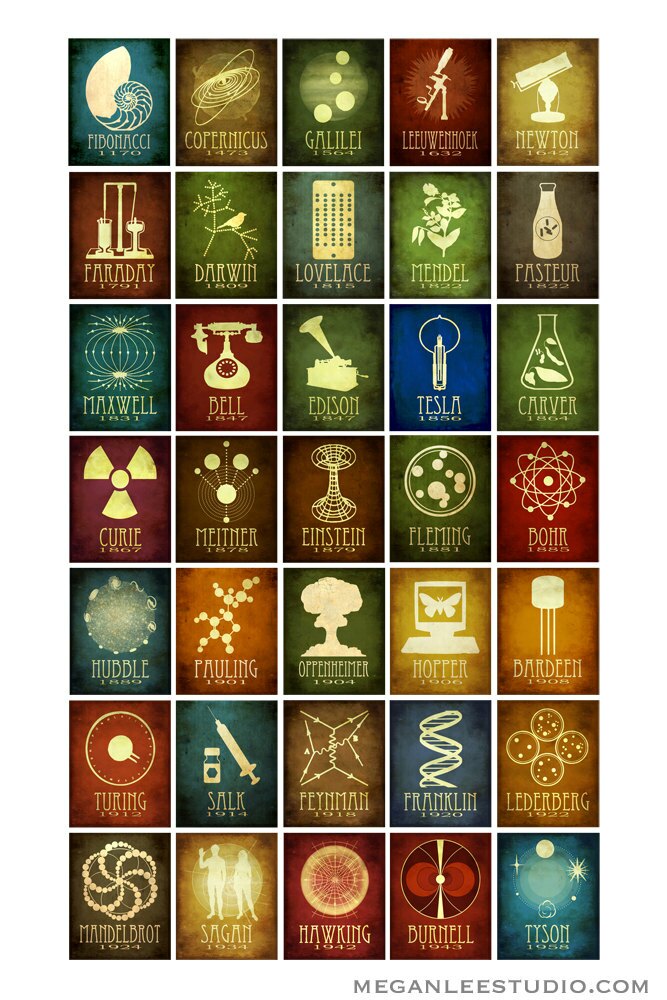오픈 이슈 갤러리 같이 보고 싶은 유머 글이나 이미지를 올려보세요!
URL 입력
-
유머
요즘 진짜 개ㅂㅅ 같은 글보면 댓글도 안 달아줌.
[6]
-
계층
폐지 줍줍
[13]
-
계층
도쿄대공습주의)2차세계대전당시 왜 미국은 일본수도 도쿄에 핵폭탄을 떨구지않고 나가사키,히로시마에 떨궛을까?
[22]
-
유머
인생의 위대한 '한 발자국' 본 부부 반응.
[12]
-
연예
엔믹스 설윤
[8]
-
연예
사나
[11]
-
연예
엔믹스 한 장
[4]
-
연예
뉴진스 다니엘 근황
[28]
-
계층
꼭 통닭 두 마리를 사서 한 마리는 경비실에 놓고 가는 입주민
[20]
-
계층
변명하는 보호자를 보고 개빡친 강형욱
[29]
이미지 업로드중입니다
(1/5)
URL 입력
ㅇㅇㄱ 지금 뜨는 글
|
2014-09-18 04:33
조회: 12,004
추천: 0
35인의 과학자들 1. 피보나치 2. 니콜라스 코페르니쿠스 3. 갈릴레오 갈릴레이 4. 안톤 필립스 레이우엔훅 5. 아이작 뉴턴 6. 마이클 패러데이 7. 찰스 다윈 8. 에이다 러브레이스 9. 그레고르 멘델 10. 루이 파스퇴르 11. 제임스 맥스웰 12. 알렉산더 벨 13. 토마스 에디슨 14. 니콜라 테스라 15. 조지 워싱턴 카버 16. 마리 퀴리 17. 리제 마이트너 18. 알버트 아인슈타인 19. 알렉산더 플레밍 20. 닐스 보어 21. 에드윈 허블 22. 라이너스 폴링 23. 로버트 오펜하이머 24. 그레이스 호퍼 25. 존 바딘 26. 앨런 튜링 27. 조너스 소크 28. 리처드 파인만 29. 로절린 프랭클린 30. 에스터 레더버그 31. 브누아 망델브로 32. 칼 세이건 33. 스티븐 호킹 34. 조슬린 벨 버넬 35. 닐 타이슨 *케플러, 라부아지에, 라이프니츠, 우장춘박사님은 어디로? 1. Leonardo Pisano Bigollo (known as Fibonacci), born 1170, was an Italian mathematician best known for a number sequence named the Fibonacci numbers, which he did not discover but used as an example in the Liber Abaci (Book of Calculation). 2. Nicolaus Copernicus, born 1473, was a Polish astronomer, physicist, and mathematician. He began a scientific revolution with his heliocentric model, placing the Sun at the center of the universe 3. Galileo Galilei, born 1564, was an Italian astronomer, physicist, and mathematician. This design represents his discovery of the four largest satellites of Jupiter, named the Galilean moons in his honor. 4. Antonie Philips van Leeuwenhoek, born 1632, was a Dutch tradesman and scientist commonly known as "the Father of Microbiology". He is considered to be the first microbiologist and is best known for his work on the improvement of the microscope. He was also the first to record microscopic observations of bacteria, muscle fibers, spermatozoa, and blood flow in capillaries. 5. Sir Isaac Newton, born 1642, was an English physicist, mathematician, astronomer, natural philosopher, alchemist, and theologian. Newton built the first practical reflecting telescope and developed a theory of color based on the observation that a prism decomposes white light into the many colors that form the visible spectrum. 6. Michael Faraday, born 1791, was an English chemist and physicist who discovered electromagnetic induction, diamagnetism, and laws of electrolysis. His inventions of electromagnetic rotary devices formed the foundation of electric motor technology, and it was largely due to his efforts that electricity became viable for use in technology. 7. Charles Darwin, born in 1809, was an English naturalist who proposed the scientific theory that all species of life have descended over time from common ancestors and that this branching pattern of evolution resulted from a process that he called natural selection. Darwin's theory was spawned from his studying of the Galápagos finches and he proposed that the evolutionary relatedness among species through time, was expressible as a metaphor he termed the Tree of Life. 8. Ada Lovelace, born Augusta Ada Byron in 1815, was an English mathematician considered to be the world's first computer programmer for her work on Charles Babbage's early mechanical generalpurpose computer, the analytical engine. The input was to be provided to the machine via punched cards, and her notes on the engine include what is recognized as the first algorithm intended to be processed by a machine. 9. Gregor Johann Mendel, born in 1822, was an Austrian scientist and Augustinian friar who worked with genetics and demonstrated that the inheritance of certain traits in pea plants follows particular patterns. It is now referred to as the laws of Mendelian inheritance. 10. Louis Pasteur, born 1822, was a French chemist and microbiologist who was one of the most important founders of medical microbiology. He was best known to the general public for inventing a method to treat milk and wine in order to prevent it from causing sickness, a process that came to be called pasteurization. 11. James Clerk Maxwell, born in 1831, was a Scottish physicist and mathematician whose prominent achievement was formulating classical electromagnetic theory. His achievements concerning electromagnetism have been called the "second great unification in physics" after the first one realized by Isaac Newton. 12. Alexander Graham Bell, born in 1847, was a scientist, inventor, and engineer and has been described as one of the most influential figures in human history. His research on hearing and speech led him to experiment with hearing devices which eventually led to him being awarded the first US patent for the telephone in 1876. 13. Thomas Alva Edison, born 1847, was an American scientist and the third most prolific inventor in history, holding 1,093 US patents in his name. Edison developed many devices including the phonograph, the motion picture camera, and direct current (DC) power. 14. Nikola Tesla, born 1856, was one of the most important contributors to the birth of commercial electricity, inventor of alternating current electric power systems, wireless power transmission, the AC Motor, radio, xray, and contributor to the establishment of robotics, remote control, radar, and computer science. 15. George Washington Carver, believed to have been born in 1864, was an American chemist and botanist who dedicated his life to developing industrial applications from agricultural crops. He is best known for educating farmers with his crop rotation method - the practice of alternating soil-depleting cotton crops with soil-enriching crops such as sweet potatoes, soybeans, and peanuts. 16. Marie Curie, born 1867, was a pioneer in the field of radioactivity, as well as the first person honored with two Nobel Prizes in both physics and chemistry. Her achievements included a theory of radioactivity, techniques for isolating radioactive isotopes, and the discovery of two elements, polonium and radium. 17. Lise Meitner, born 1878, was Nuclear physicist often mentioned as one of the most glaring examples of women's scientific achievement overlooked by the Nobel committee. Meitner was part of the team that discovered nuclear fission (when one atom splits into two and releases energy), for which her colleague Otto Hahn was awarded the Nobel Prize. In 1997, element 109 was named meitnerium in her honor. 18. Albert Einstein, born 1879, was a German born U.S. physicist best known for his theories of special relativity, general relativity, and his mass–energy equivalence formula E = mc2. 19. Alexander Fleming, born 1881, was a Scottish microbiologist best known for discovering the antibiotic substance penicillin from the mould Penicillium notatum in 1928, for which he shared the Nobel Prize in Physiology or Medicine in 1945 with Howard Florey and Ernst Boris Chain. 20. Niels Bohr, born 1885, was a Danish physicist who made fundamental contributions to understanding atomic structure and devised the Bohr model of the atom the theory that electrons travel in discrete orbits around the atom’s nucleus. 21. Edwin Hubble, born in 1889, was an American astronomer. He profoundly changed the understanding of the universe by confirming the existence of galaxies other than the Milky Way. He also devised the most commonly used system for classifying galaxies by grouping them according to their appearance in photographic images. 22. Linus Pauling, born in 1901, was an American chemist, author, and peace activist. Pauling spent much of his early life studying and writing about the electronic structure of atoms and molecules, and then later in life, the benefits of intaking high doses of Vitamin C. 23. J. Robert Oppenheimer, born 1904, was an American theoretical physicist and scientific director of the Manhattan Project a project that developed the first nuclear weapons during World War II. This led to him being remembered as “The Father of the Atomic Bomb”. 24. Grace Hopper, born 1906, was an American computer scientist and conceptualized the idea of machineindependent programming languages, which led to the development of COBOL, one of the first modern programming languages. She also popularized the term "debugging" for fixing computer glitches after being motivated by an actual moth removed from the computer. 25. John Bardeen, born 1908, was an American physicist and inventor of the transistor a semiconductor device used to amplify and switch electronic signals. It revolutionized the electronics industry and made possible the development of almost every modern electronic device. 26. Alan Turing, born 1912, was an English mathematician, logician, computer scientist, and cryptanalyst. Hw devised a number of techniques for breaking German ciphers, including the method of the bombe, an electromechanical machine that could find settings for the Enigma machine (an electromechanical rotor cipher machine used for the encryption and decryption of secret messages). 27. Jonas Salk, born 1914, was an American medical researcher and virologist. He is one of the United States's best known microbiologists, chiefly for his discovery and development of the first successful polio vaccine. 28. Richard Feynman, born in 1918, was an American physicist who developed a widely used pictorial representation scheme for the mathematical s governing the behavior of subatomic particles, which later became known as Feynman diagrams. 29. Rosalind Franklin, born 1920, was an English biophysicist who contributed to discovering the fine molecular structures of DNA, RNA, viruses, coal and graphite. Her work on Xray diffraction images of DNA led to her discovery of DNA double helix and her data was used to formulate Crick and Watson's 1953 hypothesis regarding the structure of DNA. 30. Esther Lederberg, born 1922, was an American microbiologist who devised the first successful implementation of replica plating and helped discover and understand the genetic mechanisms of specialized transduction. These contributions laid the foundation for much of the genetics work done in the latter half of the twentieth century. 31. Benoit Mandelbrot, born 1924, was a French American mathematician who worked on a wide range of mathematical problems, but is best known as the father of fractal geometry. He showed how fractals can occur in many different places in both mathematics and in nature. 32. Carl Sagan, born 1934, was an American astronomer, cosmologist and astrophysicist. He pioneered astrobiology along with promoting the search for Extra-Terrestrial Intelligence. This design represents the voyage of Pioneer 10, which bore Sagans plaque containing a pictorial message in case the spacecraft was intercepted by extraterrestrial life. 33. Stephen Hawking, born 1942, was a British cosmologist and theoretical physicist. One of his key scientific works to date is the theoretical prediction that black holes should emit radiation, which is today known as Hawking radiation. 34. Jocelyn Bell Burnell, born 1943, is a Northern Irish astrophysicist. In the mid 1960's she helped to build a four-acre radio telescope that produced 96 feet of paper data per night which she reviewed by hand. In July 1967, it was from this data that she discovered the first radio pulsars (signals coming from rapidly rotating neutron stars). Some have called this the "greatest astronomical discovery of the twentieth century." 35. Neil deGrasse Tyson, born 1958, is an American astrophysicist and author. His research covers many topics, but he is especially focused on the study of star formation, and has stated that what he likes most about the universe is the birth, lives, and deaths of stars.
EXP
279,356
(77%)
/ 285,001
God bless you!
|
 올모스트휴먼
올모스트휴먼 